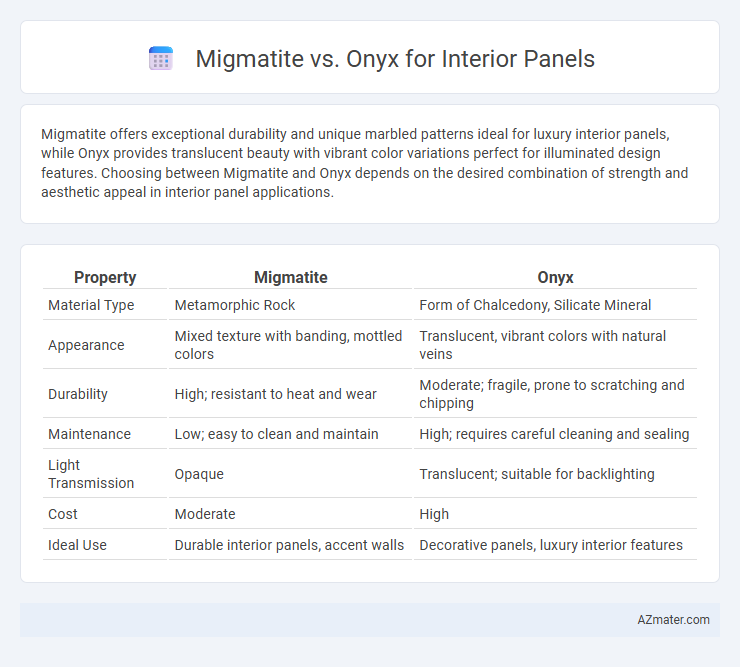Migmatite offers exceptional durability and unique marbled patterns ideal for luxury interior panels, while Onyx provides translucent beauty with vibrant color variations perfect for illuminated design features. Choosing between Migmatite and Onyx depends on the desired combination of strength and aesthetic appeal in interior panel applications.
Table of Comparison
| Property | Migmatite | Onyx |
|---|---|---|
| Material Type | Metamorphic Rock | Form of Chalcedony, Silicate Mineral |
| Appearance | Mixed texture with banding, mottled colors | Translucent, vibrant colors with natural veins |
| Durability | High; resistant to heat and wear | Moderate; fragile, prone to scratching and chipping |
| Maintenance | Low; easy to clean and maintain | High; requires careful cleaning and sealing |
| Light Transmission | Opaque | Translucent; suitable for backlighting |
| Cost | Moderate | High |
| Ideal Use | Durable interior panels, accent walls | Decorative panels, luxury interior features |
Introduction to Migmatite and Onyx
Migmatite, a naturally occurring composite rock characterized by a blend of metamorphic and igneous components, offers exceptional durability and a unique veined appearance ideal for interior panels aiming for a luxurious yet robust finish. Onyx, a translucent and visually striking banded form of chalcedony, enhances interior panels with its captivating light-reflective properties, delivering a sophisticated and elegant ambiance. Both materials provide distinctive aesthetic qualities, with migmatite excelling in strength and texture, while onyx is prized for its luminous coloration and decorative appeal.
Formation and Characteristics Overview
Migmatite forms through high-grade metamorphism, exhibiting a mixed texture of igneous and metamorphic origins with a banded appearance due to partial melting. Onyx is a variety of chalcedony formed by the deposition of calcium carbonate in cold water environments, characterized by its translucent, layered bands in shades of white, yellow, and brown. Migmatite offers durability and a unique, natural pattern ideal for rustic and geological aesthetics, while onyx provides a luxurious, luminous quality favored for elegant interior panels.
Visual Appeal: Patterns and Color Variations
Migmatite offers a unique visual appeal characterized by its swirling, banded patterns that blend light and dark minerals, creating dynamic and organic designs ideal for statement interior panels. Onyx provides a translucent quality with striking color variations ranging from creamy whites to deep amber and emerald hues, producing luxurious and vibrant panels that enhance light diffusion. Both materials add distinctive aesthetic value, with migmatite emphasizing texture and movement, while onyx emphasizes color depth and luminosity.
Durability and Strength Comparison
Migmatite offers superior durability and strength compared to Onyx, making it more suitable for high-traffic interior panels due to its harder mineral composition and resistance to scratching and chipping. Onyx, while visually striking with its translucency and unique patterns, is softer and more brittle, requiring careful handling and maintenance to prevent damage in interior applications. The dense structure of Migmatite ensures long-lasting performance under physical stress, while Onyx's delicate nature limits its use to low-impact decorative panels.
Maintenance Needs and Longevity
Migmatite offers high durability and resistance to scratches and heat, making it a low-maintenance choice for interior panels that require long-lasting performance. Onyx, prized for its translucent beauty, demands careful maintenance to prevent scratches and staining, as it is softer and more porous than migmatite. While migmatite panels can endure heavy use with minimal upkeep, onyx requires regular sealing and gentle cleaning to preserve its aesthetic appeal over time.
Cost Factors and Price Range
Migmatite offers a unique blend of natural stone patterns with durability, typically priced between $50 to $100 per square foot, making it a cost-effective option for high-end interior panels. Onyx, characterized by its translucent and luxurious appearance, commands a higher price range of $100 to $250 per square foot due to its rarity and the complexity of quarrying and processing. Cost factors for both materials include extraction difficulty, finishing processes, and installation requirements, with Onyx often incurring higher expenses related to maintenance and handling.
Light Transmission and Aesthetic Effects
Migmatite offers lower light transmission compared to Onyx, making it ideal for interiors requiring subtle, opaque finishes with natural, earthy patterns that enhance texture and depth. Onyx, known for its high translucency, allows light to pass through, creating dramatic backlit effects that emphasize its rich veining and vibrant colors in interior panels. Choosing between Migmatite and Onyx depends on desired ambiance: Migmatite provides a matte, rugged aesthetic while Onyx delivers luminous, luxurious visual impact for feature walls or decorative elements.
Application Versatility in Interior Design
Migmatite offers exceptional application versatility in interior design due to its unique combination of igneous and metamorphic rock characteristics, making it suitable for feature walls, flooring, and countertops with natural, intricate patterns. Onyx stands out for its translucency, enabling it to be backlit for dramatic lighting effects in panels, bar fronts, and decorative accents, providing a luxurious and elegant ambiance. Both materials support diverse design aesthetics, but Migmatite's durability favors high-traffic areas, while Onyx excels in creating visually striking focal points.
Sustainability and Environmental Impact
Migmatite offers superior sustainability due to its natural formation process and durability, reducing the need for frequent replacement and minimizing resource consumption. Onyx, while visually striking, often requires extensive extraction and processing, leading to higher environmental impact and energy use. Choosing migmatite for interior panels supports eco-friendly building practices by optimizing longevity and reducing carbon footprint.
Which is Better for Interior Panels?
Migmatite offers superior durability and a unique blend of metamorphic textures, making it ideal for high-traffic interior panels that require both strength and aesthetic appeal. Onyx provides a luxurious, translucent appearance with natural veining, perfect for accent panels where visual impact is prioritized over durability. For interior panels demanding long-term resilience and subtle elegance, migmatite is better, while onyx suits decorative features emphasizing light diffusion and intricate patterns.

Infographic: Migmatite vs Onyx for Interior Panel
 azmater.com
azmater.com